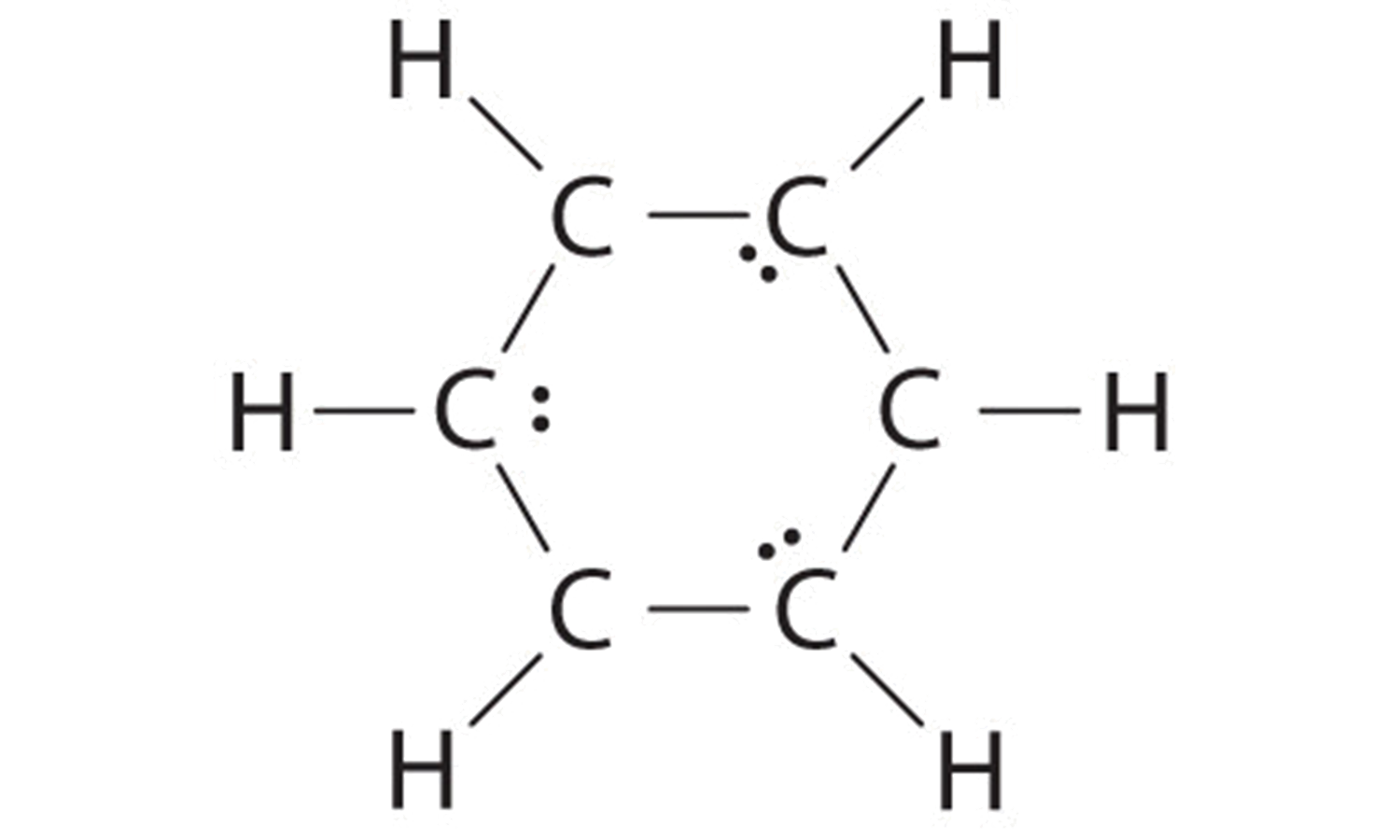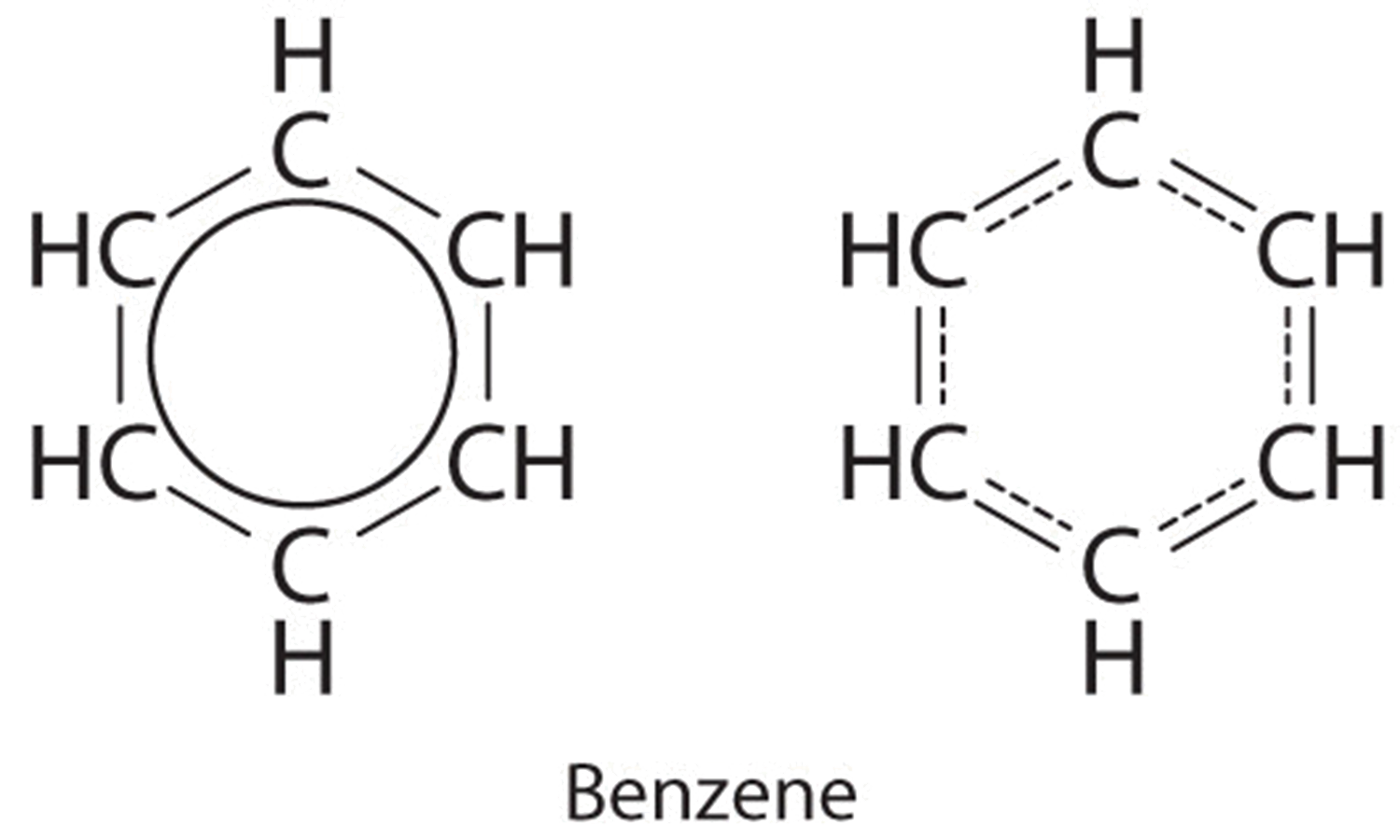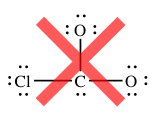9.4: Resonance Lewis Structures
- Page ID
- 170030
\( \newcommand{\vecs}[1]{\overset { \scriptstyle \rightharpoonup} {\mathbf{#1}} } \)
\( \newcommand{\vecd}[1]{\overset{-\!-\!\rightharpoonup}{\vphantom{a}\smash {#1}}} \)
\( \newcommand{\id}{\mathrm{id}}\) \( \newcommand{\Span}{\mathrm{span}}\)
( \newcommand{\kernel}{\mathrm{null}\,}\) \( \newcommand{\range}{\mathrm{range}\,}\)
\( \newcommand{\RealPart}{\mathrm{Re}}\) \( \newcommand{\ImaginaryPart}{\mathrm{Im}}\)
\( \newcommand{\Argument}{\mathrm{Arg}}\) \( \newcommand{\norm}[1]{\| #1 \|}\)
\( \newcommand{\inner}[2]{\langle #1, #2 \rangle}\)
\( \newcommand{\Span}{\mathrm{span}}\)
\( \newcommand{\id}{\mathrm{id}}\)
\( \newcommand{\Span}{\mathrm{span}}\)
\( \newcommand{\kernel}{\mathrm{null}\,}\)
\( \newcommand{\range}{\mathrm{range}\,}\)
\( \newcommand{\RealPart}{\mathrm{Re}}\)
\( \newcommand{\ImaginaryPart}{\mathrm{Im}}\)
\( \newcommand{\Argument}{\mathrm{Arg}}\)
\( \newcommand{\norm}[1]{\| #1 \|}\)
\( \newcommand{\inner}[2]{\langle #1, #2 \rangle}\)
\( \newcommand{\Span}{\mathrm{span}}\) \( \newcommand{\AA}{\unicode[.8,0]{x212B}}\)
\( \newcommand{\vectorA}[1]{\vec{#1}} % arrow\)
\( \newcommand{\vectorAt}[1]{\vec{\text{#1}}} % arrow\)
\( \newcommand{\vectorB}[1]{\overset { \scriptstyle \rightharpoonup} {\mathbf{#1}} } \)
\( \newcommand{\vectorC}[1]{\textbf{#1}} \)
\( \newcommand{\vectorD}[1]{\overrightarrow{#1}} \)
\( \newcommand{\vectorDt}[1]{\overrightarrow{\text{#1}}} \)
\( \newcommand{\vectE}[1]{\overset{-\!-\!\rightharpoonup}{\vphantom{a}\smash{\mathbf {#1}}}} \)
\( \newcommand{\vecs}[1]{\overset { \scriptstyle \rightharpoonup} {\mathbf{#1}} } \)
\( \newcommand{\vecd}[1]{\overset{-\!-\!\rightharpoonup}{\vphantom{a}\smash {#1}}} \)
\(\newcommand{\avec}{\mathbf a}\) \(\newcommand{\bvec}{\mathbf b}\) \(\newcommand{\cvec}{\mathbf c}\) \(\newcommand{\dvec}{\mathbf d}\) \(\newcommand{\dtil}{\widetilde{\mathbf d}}\) \(\newcommand{\evec}{\mathbf e}\) \(\newcommand{\fvec}{\mathbf f}\) \(\newcommand{\nvec}{\mathbf n}\) \(\newcommand{\pvec}{\mathbf p}\) \(\newcommand{\qvec}{\mathbf q}\) \(\newcommand{\svec}{\mathbf s}\) \(\newcommand{\tvec}{\mathbf t}\) \(\newcommand{\uvec}{\mathbf u}\) \(\newcommand{\vvec}{\mathbf v}\) \(\newcommand{\wvec}{\mathbf w}\) \(\newcommand{\xvec}{\mathbf x}\) \(\newcommand{\yvec}{\mathbf y}\) \(\newcommand{\zvec}{\mathbf z}\) \(\newcommand{\rvec}{\mathbf r}\) \(\newcommand{\mvec}{\mathbf m}\) \(\newcommand{\zerovec}{\mathbf 0}\) \(\newcommand{\onevec}{\mathbf 1}\) \(\newcommand{\real}{\mathbb R}\) \(\newcommand{\twovec}[2]{\left[\begin{array}{r}#1 \\ #2 \end{array}\right]}\) \(\newcommand{\ctwovec}[2]{\left[\begin{array}{c}#1 \\ #2 \end{array}\right]}\) \(\newcommand{\threevec}[3]{\left[\begin{array}{r}#1 \\ #2 \\ #3 \end{array}\right]}\) \(\newcommand{\cthreevec}[3]{\left[\begin{array}{c}#1 \\ #2 \\ #3 \end{array}\right]}\) \(\newcommand{\fourvec}[4]{\left[\begin{array}{r}#1 \\ #2 \\ #3 \\ #4 \end{array}\right]}\) \(\newcommand{\cfourvec}[4]{\left[\begin{array}{c}#1 \\ #2 \\ #3 \\ #4 \end{array}\right]}\) \(\newcommand{\fivevec}[5]{\left[\begin{array}{r}#1 \\ #2 \\ #3 \\ #4 \\ #5 \\ \end{array}\right]}\) \(\newcommand{\cfivevec}[5]{\left[\begin{array}{c}#1 \\ #2 \\ #3 \\ #4 \\ #5 \\ \end{array}\right]}\) \(\newcommand{\mattwo}[4]{\left[\begin{array}{rr}#1 \amp #2 \\ #3 \amp #4 \\ \end{array}\right]}\) \(\newcommand{\laspan}[1]{\text{Span}\{#1\}}\) \(\newcommand{\bcal}{\cal B}\) \(\newcommand{\ccal}{\cal C}\) \(\newcommand{\scal}{\cal S}\) \(\newcommand{\wcal}{\cal W}\) \(\newcommand{\ecal}{\cal E}\) \(\newcommand{\coords}[2]{\left\{#1\right\}_{#2}}\) \(\newcommand{\gray}[1]{\color{gray}{#1}}\) \(\newcommand{\lgray}[1]{\color{lightgray}{#1}}\) \(\newcommand{\rank}{\operatorname{rank}}\) \(\newcommand{\row}{\text{Row}}\) \(\newcommand{\col}{\text{Col}}\) \(\renewcommand{\row}{\text{Row}}\) \(\newcommand{\nul}{\text{Nul}}\) \(\newcommand{\var}{\text{Var}}\) \(\newcommand{\corr}{\text{corr}}\) \(\newcommand{\len}[1]{\left|#1\right|}\) \(\newcommand{\bbar}{\overline{\bvec}}\) \(\newcommand{\bhat}{\widehat{\bvec}}\) \(\newcommand{\bperp}{\bvec^\perp}\) \(\newcommand{\xhat}{\widehat{\xvec}}\) \(\newcommand{\vhat}{\widehat{\vvec}}\) \(\newcommand{\uhat}{\widehat{\uvec}}\) \(\newcommand{\what}{\widehat{\wvec}}\) \(\newcommand{\Sighat}{\widehat{\Sigma}}\) \(\newcommand{\lt}{<}\) \(\newcommand{\gt}{>}\) \(\newcommand{\amp}{&}\) \(\definecolor{fillinmathshade}{gray}{0.9}\)Learning Objectives
- Use resonance structures to show electron delocalization.
- Use formal charges to determine major and minor resonance contributors.
Sometimes one Lewis Structure is not Enough
Some molecules or ions cannot be adequately described by a single Lewis structure. For example, drawing one Lewis structure for ozone (O3) gives us a misleading picture of the actual bonding in the molecule. If we draw a Lewis structure for O3 (ozone), we get this:

This structure predicts that the two bonds are different lengths and strengths, because double bonds are shorter and stronger than single bonds. However, this prediction in incorrect; the two bonds in O3 are actually identical in length and strength.
Resonance is a way of describing delocalized electrons within certain molecules or polyatomic ions where the bonding cannot be expressed by a single Lewis formula. A molecule or ion with such delocalized electrons is represented by several contributing structures (also called resonance structures or resonance contributors). The basic concept of resonance theory is the following:
Whenever you can draw two or more equivalent Lewis structures for a molecule, the actual molecule behaves like the average of the possible structures.
Applying resonance theory to O3
Let’s apply resonance theory to O3. For this molecule, we can draw two equivalent structures, as shown below:

Using resonance theory, we predict that the true structure of ozone is the average of these two structures. But how do you take the average of two chemical structures?? When we take the average of two structures, we are really taking the average of two things: the bond orders and the formal charges.
Let’s begin with bond orders. We start by looking at the order of the left-hand bond in each structure. (Remember that the bond order is the number of electron pairs between two atoms. For a single bond, the bond order is 1; for a double bond, it’s 2; and for a triple bond, it’s 3.)

One structure tells us that this is a double bond, while the other tells us that it’s a single bond. The actual order of the left-hand bond should be the average of these two numbers, which is 1.5. Next, we focus on the right-hand bond. Again, one structure tells us that it is a double bond, while the other tells us that it’s a single bond.

The actual order of the right-hand bond should be the average of these two numbers, which is also 1.5. Based on resonance theory, the molecule should have two equal bonds, each of which has an order of 1.5. We can depict this using lines to represent partial bonds:

When we want to show that we must use resonance theory to understand the behavior of a molecule, we draw all of the legitimate structures and use double-sided arrows to mean “take the average of these.”

We can also use resonance theory to refine our understanding of formal charges. The formal charges in each structure are shown below.

In resonance theory, we take the average of the formal charges on each atom. For the central atom, the formal charge is +1 in both structures, and the average of +1 and +1 is +1. For the left-hand atom, we are finding the average of 0 and –1, which is –½ . For the right-hand atom, we are finding the average of –1 and 0, which is also –½ . Therefore, resonance theory gives us the following charges:

In ozone, then, the central atom is positively charged, and the outer atoms are negatively charged (and have equal charges). The overall picture of ozone that we end up with is…

Or if we have used the Valence Shell Electron Pair Repulsion Theory (VSEPR) to determine the three-dimensional shape:

Applying resonance theory to CO32–
The carbonate ion is an example of a molecule for which we can draw three equivalent structures. Each structure has one double bond and two single bonds, suggesting that one of the bonds is shorter than the other two. However, since the structures are equivalent, we must take the average of the three to get an accurate picture of carbonate.

Once again, we have to consider one bond at a time. Let’s start with the vertical bond:

The true order of this bond is the average of these three numbers:
(1 + 2 + 1) ÷ 3 = 4/3
Next, let’s do the right-hand bond:

The true order of this bond is the average of these three numbers:
(1 + 1 + 2) ÷ 3 = 4/3 (the same as the vertical bond)
Finally, we do the left-hand bond:
The true order of this bond is the average of these three numbers:
(2 + 1 + 1) ÷ 3 = 4/3 (the same as the other two bonds)
Using the resonance theory, we predict that the three bonds in the carbonate ion should be identical, with a bond order of 4/3. In fact, this is correct: the three bonds in the carbonate ion really are the same length. Also, these three bonds are shorter than a typical C–O single bond, and they are longer than a typical C=O double bond.
For the formal charges, we first work out the formal charge on each atom in each structure.

Then we look at each atom. The central carbon atom has a charge of zero in all structures, so its charge is zero when we take the average. For the left-hand oxygen, the charge is zero in the first structure and –1 in the other two; the average is (0 + -1 + -1) ÷ 3 = -2/3. The other two oxygen atoms give the same result, so all three oxygen atoms have a charge of -2/3. The overall bonding picture that results is:

The three dimensional shape is that predicted by Valence Shell Electron Repulsion Theory.
Example \(\PageIndex{1}\): Benzene
Benzene is a common organic solvent that was previously used in gasoline; it is no longer used for this purpose, however, because it is now known to be a carcinogen. The benzene molecule (\(\ce{C6H6}\)) consists of a regular hexagon of carbon atoms, each of which is also bonded to a hydrogen atom. Use resonance structures to describe the bonding in benzene.
Given: molecular formula and molecular geometry
Asked for: resonance structures
Strategy:
- Draw a structure for benzene illustrating the bonded atoms. Then calculate the number of valence electrons used in this drawing.
- Subtract this number from the total number of valence electrons in benzene and then locate the remaining electrons such that each atom in the structure reaches an octet.
- Draw the resonance structures for benzene.
Solution:
A Each hydrogen atom contributes 1 valence electron, and each carbon atom contributes 4 valence electrons, for a total of (6 × 1) + (6 × 4) = 30 valence electrons. If we place a single bonding electron pair between each pair of carbon atoms and between each carbon and a hydrogen atom, we obtain the following:

Each carbon atom in this structure has only 6 electrons and has a formal charge of +1, but we have used only 24 of the 30 valence electrons.
B If the 6 remaining electrons are uniformly distributed pairwise on alternate carbon atoms, we obtain the following:

Three carbon atoms now have an octet configuration and a formal charge of −1, while three carbon atoms have only 6 electrons and a formal charge of +1. We can convert each lone pair to a bonding electron pair, which gives each atom an octet of electrons and a formal charge of 0, by making three C=C double bonds.
C There are, however, two ways to do this:

Each structure has alternating double and single bonds, but experimentation shows that each carbon–carbon bond in benzene is identical, with bond lengths (139.9 pm) intermediate between those typically found for a C–C single bond (154 pm) and a C=C double bond (134 pm). We can describe the bonding in benzene using the two resonance structures, but the actual electronic structure is an average of the two. The existence of multiple resonance structures for aromatic hydrocarbons like benzene is often indicated by drawing either a circle or dashed lines inside the hexagon:

Exercise \(\PageIndex{1}\): Nitrate Ion
The sodium salt of nitrite is used to relieve muscle spasms. Draw two resonance structures for the nitrite ion (NO2−).
- Answer
-

Resonance structures are particularly common in oxoanions of the p-block elements, such as sulfate and phosphate, and in aromatic hydrocarbons, such as benzene and naphthalene.
What resonance is NOT…
There are three common misunderstandings about resonance theory. Be careful not to fall into these traps!
1) Resonance does not mean that the molecule goes back and forth between the structures.
Ozone does not go back and forth between the two structures we can draw. It never has one short bond and one long bond.
Ozone never looks like this: O=O—O
Ozone never looks like this either: O—O=O
Instead, it always looks like this: 
2) In resonance, you can only move electrons. Never move atoms.
For example, the following two structures are not legitimate resonance structures, because we have moved the hydrogen atom. The true structure of HCO3– is not the average of these two structures.

However, the two structures below are legitimate resonance structures, and we would need to average them to find the true structure of bicarbonate ion.

3) Resonance structures cannot disobey the octet rule.
In the example below (the chloroformate ion, ClCO2–), the first two structures are legitimate, but the third and fourth structures violate the octet rule (the central atom has only six electrons in structure #3, and it has ten electrons in structure #4).

The structure below is also incorrect, but for a different reason. It obeys the octet rule, but HCO2– must have a total of 18 electrons, and the structure below has 20. This would be the structure of HCO23–.

In general, all legitimate resonance structures for a given molecule will have the same number of double bonds.
Finally, the structure below is also incorrect, but for yet another reason: chlorine is in group 7A, and the group 7A elements cannot form double bonds.

What if resonance structures are not equivalent?
Sometimes, it’s possible to draw two legitimate Lewis structures for the same arrangement of atoms without the structures being equivalent. For example, consider the following two structures for nitrous acid, HNO2.

Both of these structures obey the rules for drawing Lewis structures; they have the correct number of electrons, and all atoms (other than H) obey the octet rule. In addition, we have not moved any atoms around; both structures have the arrangement H–O–N–O. However, the structures are not equivalent. In the first structure, the two oxygen atoms have the bonding patterns –O– and =O. In the second structure, the two oxygen atoms have the bonding patterns –O= and –O. When two resonance structures are not equivalent, the real molecule will most closely resemble the structure that has more atoms with zero formal charge. Working out formal charges for the atoms in these structures, we get:

In the left-hand structure, all formal charges are zero, but the right-hand structure has two non-zero formal charges. Therefore, the true structure of HNO2 looks more like the structure on the left. To envision this, we can start by drawing the average of the two structures. Then, the true structure will be somewhere between the average and the left-hand structure.
The average of the two structures would look like this (considering the bond orders only):

The left-hand structure from the previous page looked like this:

The real structure of HNO2 lies somewhere between these two.

The actual bond distances in this molecule are 146 pm for the left-hand N–O bond and 120 pm for the right-hand N–O bond, agreeing with our picture.
Instead of drawing a structure with dashed lines to represent partial bonds, chemists normally draw the resonance structures and label them as a “major contributor” or a “minor contributor.” The major contributor is the structure that has the most zeroes; the actual molecule will look most like the major contributor.

We also encounter situations where the formal charges are the same in both structures, but the atoms that hold the non-zero formal charges are different. The C2H3O– ion is an example. Here are the two possible resonance structures for this ion, with the non-zero formal charges included.

Both structures have five atoms with zero formal charge and one atom with a formal charge of –1. In such cases, the true structure resembles the structure that has the negative charge on the atom with the higher electronegativity (or the positive charge on the atom with the lower electronegativity). Oxygen has a higher electronegativity than carbon (3.5 versus 2.5), so the left-hand structure is the major contributor. We can represent this as follows:

Here is a sketch that might help you envision what the real molecule would look like. The negative charges are included; the larger minus sign means that there is a larger negative charge on the oxygen atom.

Example \(\PageIndex{3}\): The Thiocyanate Ion
The thiocyanate ion (SCN−), which is used in printing and as a corrosion inhibitor against acidic gases, has at least two possible Lewis electron structures. Draw two possible structures, assign formal charges on all atoms in both, and decide which is the preferred arrangement of electrons.
Given: chemical species
Asked for: Lewis electron structures, formal charges, and preferred arrangement
Strategy:
- Use the step-by-step procedure to write two plausible Lewis electron structures for SCN−.
- Calculate the formal charge on each atom using Equation \(\ref{9.6.1}\).
- Predict which structure is the major contributor based on the formal charge on each atom and its electronegativity relative to the other atoms present.
Solution:
A Possible Lewis structures for the SCN− ion are as follows:

B We must calculate the formal charges on each atom to identify the more stable structure. If we begin with carbon, we notice that the carbon atom in each of these structures shares four bonding pairs, the number of bonds typical for carbon, so it has a formal charge of zero. Continuing with sulfur, we observe that in (a) the sulfur atom shares one bonding pair and has three lone pairs and has a total of six valence electrons. The formal charge on the sulfur atom is therefore \( 6-\left ( 6+\frac{2}{2} \right )=-1.5-\left ( 4+\frac{4}{2} \right )=-1 \) In (c), nitrogen has a formal charge of −2.
C Which structure is preferred? Structure (b) is preferred because the negative charge is on the more electronegative atom (N), and it has lower formal charges on each atom as compared to structure (c): 0, −1 versus +1, −2.
Exercise \(\PageIndex{1}\): The Fulminate Ion
Salts containing the fulminate ion (CNO−) are used in explosive detonators. Draw three Lewis electron structures for CNO− and use formal charges to predict which is more stable. (Note: N is the central atom.)
Answer

The second structure is predicted to be more stable.
Summary
Resonance occurs when we can draw two or more legitimate Lewis structures for the same molecule.
Resonance only occurs when a molecule has at least one double bond. Molecules with only single bonds never show resonance.
Resonance structures must all have the correct number of electrons and must all obey the octet rule.
All resonance structures must have the atoms in the same positions. (“Don’t move the letters – just move dots and lines.”)
All resonance structures for a given molecule have the same number of double bonds.
If all resonance structures are equivalent, the true molecule is the average of the resonance structures.
If the resonance structures are not equivalent, the true molecule looks more like…
· …the structure with the most zeroes (formal charges), or…
· …the molecule with the negative charge on the atom with the highest electronegativity and/or the positive charge on the atom with the lowest electronegativity.
Contributors and Attributions
- James Armstrong, City College of San Francisco
- Torrey Glenn, City College of San Francisco


